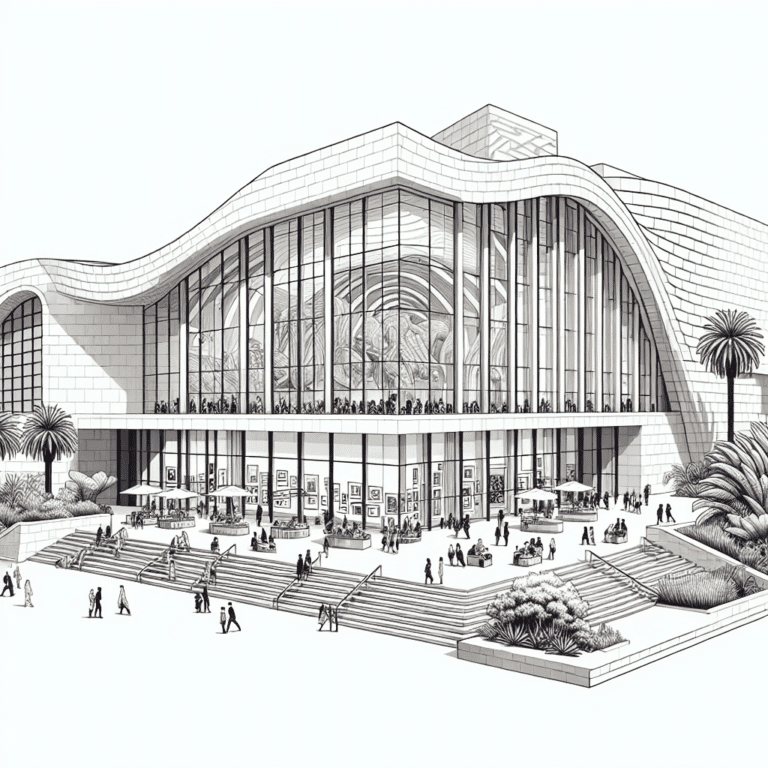Unleashing the Past: My Exciting Trip to La Brea Tar Pits and Museum
Discovering the La Brea Tar Pits
Unveiling Ancient Treasures
Visiting the La Brea Tar Pits was an adventure that truly transported me back in time. Located right in urban Los Angeles, this site is one of the world’s most famous fossil locations. Over 3.5 million fossils have been recovered from these prehistoric tar pits, making it a treasure trove of ancient history. As I walked around the tar pits, I could see researchers and paleontologists hard at work, actively excavating and uncovering new fossils. It was fascinating to witness the ongoing discoveries that provide insights into the prehistoric era.
The George C. Page Museum, located right next to the tar pits, showcases an impressive collection of Ice Age fossils. Here, I marveled at the remains of creatures that once roamed the Earth, including mammoths and saber-toothed cats. Each exhibit told a story of survival and adaptation in a world that was vastly different from our own.
The Significance of Fossils
The fossils found at La Brea are not just remnants of the past; they are valuable pieces of information about the Pleistocene epoch. They offer insights into the flora and fauna that existed during that time, including iconic species such as dire wolves and giant ground sloths (Wikipedia). The study of these fossils helps scientists understand the ecosystems that thrived and the changes that occurred over thousands of years.
As I explored the museum, I learned that the tar pits formed when crude oil seeped to the surface through fissures in the Earth’s crust, leaving sticky pools of tar. This natural phenomenon not only preserved the remains of these creatures but also attracted them, leading to their entrapment. The historical uses of tar by local Native Americans as glue and waterproof caulking added another layer of significance to my visit.
Visiting the La Brea Tar Pits and Museum was more than just a fun day out; it was an exciting journey into our planet’s history. For anyone looking for a remarkable experience in Los Angeles, this site is a must-see among the best los angeles museums.
Exploring the George C. Page Museum
Visiting the La Brea Tar Pits is an adventure like no other, and the George C. Page Museum is the crown jewel of this experience. Here, I was able to dive deep into the fascinating world of Ice Age fossils and gain valuable paleontological insights.
Ice Age Exhibits
The Ice Age exhibits at the George C. Page Museum are a highlight of my visit. They showcase an impressive collection of fossils obtained directly from the tar pits. The museum houses one of the richest and best-preserved assemblages of Pleistocene vertebrates, featuring at least 59 species of mammals and over 135 species of birds. This means there are over 660 species of organisms represented, giving me a firsthand look at life in southern California from 40,000 to 8,000 years ago.
| Exhibit Type | Number of Species |
|---|---|
| Mammals | 59 |
| Birds | 135 |
| Total Species | 660+ |
Seeing the fossils of iconic creatures like the Smilodon californicus, the famous saber-toothed cat, was truly exhilarating. The museum displays hundreds of thousands of bones representing thousands of individuals of this fascinating species, allowing me to appreciate the scale of life that once roamed this area.
Paleontological Insights
The George C. Page Museum not only displays fossils but also offers enlightening paleontological insights. I learned about the various research projects underway, which focus on understanding the ecology of the Pleistocene epoch. The museum highlights how the gray wolf, once prevalent in the region, coexisted with the dire wolf during the Ice Age. This exploration of ancient habitats and animal interactions gave me a deeper appreciation for the complexities of prehistoric life (UCMP Berkeley).
The exhibits are designed to engage visitors of all ages, making it a perfect outing for families seeking a fun and educational experience in Los Angeles. If you’re looking for more exciting museum options, consider checking out the best Los Angeles museums or other notable sites like the Getty Center and the California Science Center. The George C. Page Museum is not just about fossils; it’s a window into a world that shaped our planet, and I can’t recommend visiting enough!
Active Excavations and Ongoing Discoveries
Research in Progress
Visiting the La Brea Tar Pits is like stepping into a live science lab! The site is still actively excavated by researchers and paleontologists, providing ongoing discoveries that reveal more about the prehistoric era (Wikipedia). Each season brings new findings, and I was thrilled to learn how these excavations contribute to our understanding of life during the Pleistocene.
The La Brea Tar Pits are home to one of the richest and best-preserved assemblages of Pleistocene vertebrates. With at least 59 species of mammals and over 135 species of birds identified, the discoveries illuminate what life was like in Southern California from 40,000 to 8,000 years ago. In total, there are more than 660 species of organisms documented here (UCMP Berkeley).
| Species Count | Mammals | Birds | Total Species |
|---|---|---|---|
| 660+ | 59 | 135 | 660+ |
Insights into Prehistory
The insights gained from these excavations are invaluable. About 90% of the mammal fossils found here represent carnivores, which is fascinating. This high concentration of carnivorous fossils is attributed to entrapment in the tar pits, likely due to carnivorous mammals pursuing prey into the sticky tar. Over 30,000 years, this has led to a significant collection of predator fossils.
Two of the most notable species unearthed include the gray wolf, originally known as Canis milleri, and the famous Smilodon californicus, or sabre-toothed cat. The latter is particularly exciting, with hundreds of thousands of bones discovered that represent thousands of individuals. This not only showcases the diversity of life during that era but also provides a glimpse into the ecology of prehistoric California (UCMP Berkeley).
The La Brea Tar Pits and Museum is a must-visit for anyone interested in natural history. I left feeling inspired by the ongoing research and the incredible stories these fossils tell about our planet’s past. For more enriching experiences in Los Angeles, check out our list of the best Los Angeles museums.
Pleistocene Fauna at La Brea Tar Pits
Iconic Prehistoric Creatures
Visiting the La Brea Tar Pits was like stepping into a time machine! The fossils uncovered here provide a fascinating glimpse into the Pleistocene epoch, showcasing a variety of iconic prehistoric creatures. From the massive mammoths to the fearsome saber-toothed cats, these ancient animals roamed Southern California between 40,000 and 8,000 years ago. I was amazed to learn that the tar pits contain one of the richest and best-preserved collections of Pleistocene vertebrates, with at least 59 species of mammals and over 135 species of birds discovered so far.
Here’s a quick look at some of the most notable Pleistocene fauna I encountered:
| Creature | Description |
|---|---|
| Mammoths | Large, elephant-like creatures with long tusks. |
| Dire Wolves | Larger than modern wolves, known for pack hunting. |
| Smilodon Californicus | The famous saber-toothed cat with elongated canines. |
| Saber-toothed Cats | Renowned for their hunting skills and powerful build. |
Mammoths, Dire Wolves, and More
I was particularly fascinated by the mammoths and dire wolves. The mammoths were massive herbivores that depended on vast grasslands, while the dire wolves were formidable hunters, making them the apex predators of their time. Did you know that about 90% of the mammal fossils found at La Brea represent carnivores? This high concentration is attributed to their entrapment in the tar pits, often while chasing prey (UCMP Berkeley).
Among the most famous fossils is that of Smilodon californicus, the saber-toothed cat. This species is the second most common fossil found at La Brea, with hundreds of thousands of bones discovered, representing thousands of individuals. I learned that these fossils were first described in 1932 and have become a significant part of the University of California Museum of Paleontology collections (UCMP Berkeley).
Exploring the La Brea Tar Pits and Museum was an unforgettable experience that ignited my curiosity about these magnificent creatures and their place in history. If you’re looking for more exciting museums in Los Angeles, be sure to check out the best Los Angeles museums for your next adventure!
Formation of the Tar Pits
Visiting the La Brea Tar Pits and Museum was an unforgettable experience that allowed me to dive deep into the fascinating history of these natural wonders. The formation of the tar pits is a captivating natural phenomenon that has been occurring for thousands of years.
Natural Phenomenon
The tar pits at La Brea formed when crude oil seeped to the surface through fissures in the Earth’s crust. This process left behind heavy tar, or asphalt, in sticky pools that would become a unique site for both history and paleontology. The natural seepage created an environment where animals would become trapped, preserving their remains for future study. It’s astonishing to think that these tar pits have been around for so long and have played a significant role in revealing the secrets of prehistoric life.
Here’s a quick overview of the formation process:
| Formation Stage | Description |
|---|---|
| Crude Oil Seepage | Oil seeps through the Earth’s crust |
| Tar Pool Formation | Heavy tar accumulates in sticky pools |
| Animal Trapping | Animals become trapped, preserving fossils |
Historical Uses of Tar
The historical significance of the tar is just as intriguing. Local Native Americans utilized this natural resource for thousands of years, using it as glue and waterproof caulking. The tar’s versatility made it an essential part of their daily lives. Later, Westerners recognized its potential and began mining the tar for various purposes, such as roofing materials.
This rich history adds another layer to the La Brea Tar Pits, making it not only a paleontological treasure but also a site of cultural importance. For anyone interested in exploring more about the best museums in Los Angeles, including the La Brea Tar Pits, check out our guide on the best los angeles museums. The combination of natural history and human ingenuity creates a compelling narrative that makes this site a must-visit in Los Angeles.
Richness of Fossils at La Brea
The La Brea Tar Pits are a treasure trove of history and intrigue. As I explored this remarkable site, I was captivated by the sheer abundance and variety of fossils that have been recovered over the years.
Diverse Vertebrates
La Brea is renowned for its remarkable fossil collection, with over 3.5 million fossils unearthed from the tar pits. The site contains one of the richest and best-preserved assemblages of Pleistocene vertebrates in the world. From my visit, I learned that La Brea features:
| Category | Count |
|---|---|
| Species of Mammals | 59 |
| Species of Birds | 135 |
| Total Species of Organisms | 660 |
This incredible diversity offers a glimpse into life in southern California from 40,000 to 8,000 years ago (UCMP Berkeley). The fossils include iconic creatures such as mammoths, dire wolves, and saber-toothed cats.
Insights into Prehistoric Life
The fossils from La Brea provide invaluable insights into the Pleistocene epoch, revealing the dynamics of ancient ecosystems. I discovered that about 90% of the mammal fossils represent carnivores, along with most of the bird fossils, which are predominantly predators or scavengers. This high concentration of carnivores is likely due to their entrapment in the tar pits, possibly while chasing prey (UCMP Berkeley).
One of the standout species is Smilodon californicus, the famous saber-toothed cat. It is the second most common fossil found at La Brea, with hundreds of thousands of bones representing thousands of individuals. These fossils were first documented in 1932 and are now part of the University of California Museum of Paleontology collections (UCMP Berkeley).
The La Brea Tar Pits and Museum is not only a fascinating destination but also a key site for understanding prehistoric life. Whether you are a history buff or just curious about the past, this museum offers a unique and exciting experience for all ages. For more intriguing exhibits, check out other attractions like the Getty Center or the Natural History Museum of Los Angeles County.
Predominance of Carnivores at La Brea
Tar Pit Trapping
Visiting the La Brea Tar Pits and Museum, I was fascinated to learn that about 90% of the mammal fossils found here represent carnivores. This high concentration of predators is attributed to the unique trapping mechanism of the tar pits. The sticky tar would ensnare not only the carnivores but also their prey, creating a remarkable snapshot of prehistoric life.
It’s believed that packs of carnivorous mammals may have chased their prey into the pits, leading to a significant number of fossils accumulating over the past 30,000 years. This event highlights how the tar pits served as both a hunting ground and a deadly trap for these animals, providing us with invaluable insights into their behavior and interactions.
| Fossil Type | Percentage Found |
|---|---|
| Carnivorous Mammals | 90% |
| Bird Fossils | Predators/Scavengers |
For those interested in the details of these fascinating fossils, the La Brea Tar Pits is an essential stop among the best Los Angeles museums.
Pack Dynamics
The dynamics within packs of carnivores also provide intriguing insights into their behavior. The high concentration of carnivorous species, including the infamous saber-toothed cat, suggests a complex social structure where cooperation played a vital role in hunting strategies.
The presence of multiple carnivores in the tar pits implies that they may have hunted in groups, which would have increased their chances of successfully capturing prey. This cooperative behavior is critical for survival, especially in a competitive environment filled with other predators.
As I walked through the exhibits, I couldn’t help but imagine the bustling activity of these prehistoric beasts, working together to secure their next meal. Understanding these pack dynamics adds another layer to the allure of the La Brea Tar Pits, making it a must-visit destination for anyone interested in the natural history of Los Angeles and beyond.
For more exciting exhibits and experiences in Los Angeles, consider visiting other fantastic locations like The Getty Center or the California Science Center.
Famous Species at La Brea Tar Pits
The La Brea Tar Pits and Museum is home to some of the most fascinating prehistoric creatures that roamed the Earth during the Pleistocene epoch. Among these, the gray wolf and the iconic Smilodon californicus stand out as remarkable species that excite visitors and researchers alike.
Gray Wolf and Dire Wolf
The gray wolf, scientifically known as Canis milleri, is a significant species from the Pleistocene period. It coexisted with the dire wolf, C. dirus, making the tar pits a unique site for examining their interactions. Gray wolves had a vast natural range and could be found in nearly all habitats of the Northern Hemisphere, except deserts and tropical areas. Unfortunately, today, they have been largely exterminated in various regions due to habitat loss and human activity.
| Characteristic | Gray Wolf | Dire Wolf |
|---|---|---|
| Scientific Name | Canis milleri | C. dirus |
| Range | Northern Hemisphere (excluding deserts and tropics) | Primarily North America |
| Notable Facts | Vast natural range, social pack behavior | Larger than modern wolves, robust build |
Smilodon Californicus
The Smilodon californicus, commonly known as the saber-toothed cat, is perhaps the most famous resident of the La Brea Tar Pits. This species is the second most common fossil found at the site, with hundreds of thousands of bones representing thousands of individuals uncovered. The fossils were first described in 1932 by Professor John C. Merriam and his student Chester Stock, and they are now part of the collections at the University of California Museum of Paleontology (UCMP Berkeley).
| Characteristic | Description |
|---|---|
| Common Name | Saber-toothed cat |
| Scientific Name | Smilodon californicus |
| Fossil Count | Hundreds of thousands of bones |
| Historical Significance | Represents a significant component of Pleistocene fauna |
Both the gray wolf and Smilodon californicus provide incredible insight into the prehistoric ecosystem of Los Angeles. Visiting the La Brea Tar Pits allows individuals and families to experience this rich history firsthand. For more exciting discoveries in the area, check out the best los angeles museums that showcase the region’s unique heritage.







